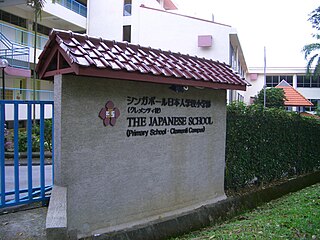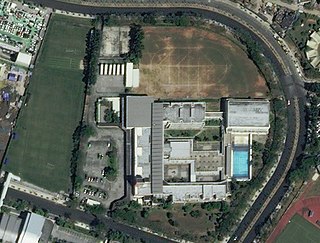
Nihonjin gakkō, also called Japanese school, is a full-day school outside Japan intended primarily for Japanese citizens living abroad. It is an expatriate school designed for children whose parents are working on diplomatic, business, or education missions overseas and have plans to repatriate to Japan.
Konza is a small town in Makueni County, Kenya. It is located 40 kilometres (25 mi) south-east of Nairobi, the Kenyan capital.

Taipei Japanese School (TJS) is a Japanese international school located in Shilin District, Taipei. TJS was established in 1947 and mainly serves the children of Japanese expatriates in Taiwan.
The Thai Japanese Association School is a Japanese school located in Huai Khwang District, Bangkok on Rama 9 Road. It is sponsored by the Thai-Japanese Association. It is the school with the largest campus in Bangkok, and one of the two Japanese schools in Bangkok. It allows students from junior school Grade 1 students to middle school Grade 3 students to learn. The school only allows students with a Japanese nationality to study.

The Japanese School of Kuala Lumpur is a Japanese international school in Saujana Golf and Country Club in Subang, Selangor, Malaysia. The syllabus at this school is based on the Japanese Education Curriculum.

The Manila Japanese School, is a Japanese school located at the Bonifacio Global City in Taguig, Philippines. It caters mainly to Japanese students who are residing in the Metro Manila area.

Japanese School of Beijing (JSB) is a Japanese education day school in Chaoyang District, Beijing. The students are children of diplomats, businesspeople, and workers in foreign institutions. The school currently has approximately 640 students. It is only open to Japanese students.

The Japanese School in London is a Japanese international school in Acton, London Borough of Ealing. The school is incorporated as The Japanese School Limited. The Japanese Saturday School in London, a Japanese supplementary school, is a part of the institution.

The Japanese School Singapore is a Japanese international school in Singapore, covering elementary and junior high school levels. There are two separate elementary schools of the JSS in Clementi and Changi, while junior high school division is located in West Coast. As of 2013 this Japanese international school is the largest overseas Japanese school in the world.

The Japanese School of Brussels a.s.b.l. is a Japanese international school located in Auderghem, Brussels. The school serves elementary and junior high school levels. It is Belgium's only Japanese international school. The Japanese Supplementary School of Brussels, a supplementary school operated on Saturdays, is held on the premises of the JSB.

Japanese School in Moscow is a Japanese international school located in Lomonosovsky District, South-Western Administrative Okrug, Moscow. It was established in 1967. It occupies the fourth and fifth floors of its building, which is also used by the Moscow Finnish School, the Swedish School in Moscow, and the Scuola Italiana Italo Calvino. The campus also has a dining hall, an indoor gymnasium, a technical classroom, a playing field that doubles as a skating rink in the winter, and outdoor athletic fields.
Istanbul Japanese School is a Japanese international school located in Etiler, Beşiktaş, Istanbul, Turkey.

The Institut Culturel Franco-Japonais – École Japonaise de Paris is a Japanese international school located in Montigny-le-Bretonneux, France, in the Paris Metropolitan Area. The school is located in proximity to Versailles. Japanese is the primary language of instruction while students also take French classes.

The Shanghai Japanese School (SJS) is a Japanese international school serving primary and junior high school levels in Shanghai. It has two campuses, one in Hongqiao and one in Pudong. The school's teachers are Japanese citizens. The school also has a senior high school component.

The Escola Japonesa de São Paulo is a Japanese international day school in Vila Prel, Capão Redondo, Subprefecture of Campo Limpo, São Paulo, operated by the Sociedade Japonesa de Educação e Cultura. It serves students from 6 to 15 years of age in grades 1 through 9. Most of the students have Japanese company executives as parents. The school uses the Japanese curriculum.

The Hong Kong Japanese School and Japanese International School (HKJS&JIS) is a Japanese international school in Hong Kong. It consists of a Japanese section and international section. The Hong Kong Japanese School Limited operates the school system.
Portland Japanese School is a Japanese weekend supplementary school located in the Portland metropolitan area. The school has its office in Park Plaza West in Beaverton, and its classes are held at Hazelbrook Middle School in Tualatin. The Japanese Business Association of Portland, also known as the "Shokookai," oversees the school, which serves levels PK through 12.

The Kaohsiung Japanese School is a Japanese international school on the campus of Kaohsiung Municipal Lingya District Jhong-Jheng Elementary School in Lingya District, Kaohsiung, Taiwan in the Republic of China.

Taichung Japanese School is a Japanese international school in Daya District, Taichung, Taiwan in the Republic of China.
Japanese School of Hanoi is a Japanese international school in Nam Từ Liêm, Hanoi, Vietnam. It serves elementary school and junior high school.

















